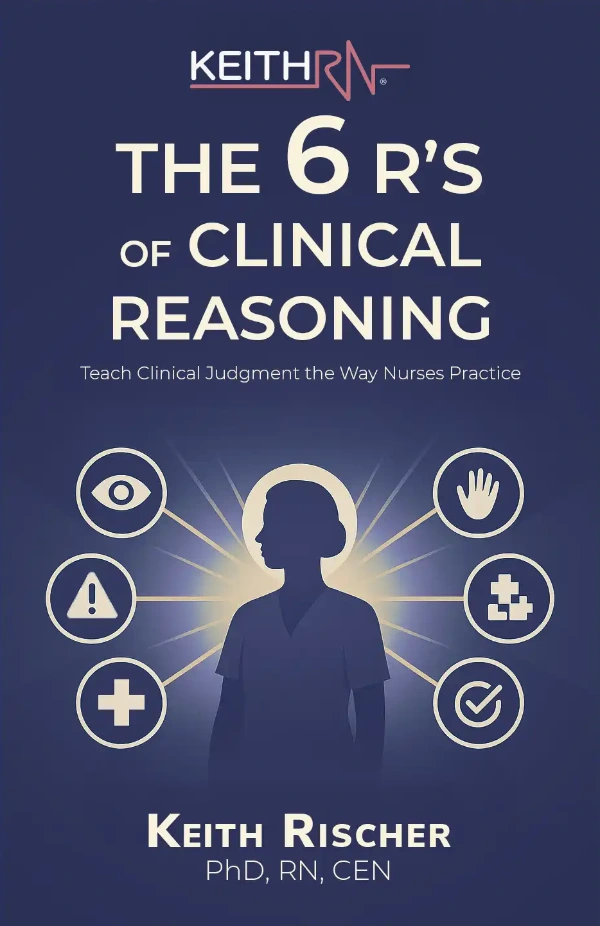
Safety is the unifying thread for everything that is done by the professional nurse.
Though safety is traditionally applied to patient care and medication administration, patient safety can be impacted if there is inadequate communication with other nurses or care providers.
Every time a nurse communicates a clinical concern or gives report to the oncoming nurse, this is a HIGH RISK encounter that will directly impact patient care one way or another.
Though the SBAR format (situation/background/assessment/recommendation) is typically taught as a framework for nurse-to-nurse communication, I believe that this structure can be too ambiguous for novice nursing students. See my past blog on what more is needed than the SBAR to strengthen clinical communication.
I have created a new tool that adds scaffolding to the SBAR to strengthen student clinical communication.
Has This Happened to You?
As a nurse educator who remains current in both critical care and ED, nurse-to-nurse report is inconsistent.
I have had experienced nurses with decades of experience read off the chart EVERYTHING on the kardex and most recent labs, without any sense of salience or recognition for what is truly relevant.
I have had new nurses with less than a year of experience rock it with a concise hand off that communicates the essence of what is needed to safely transfer care to myself.
We want our students to be this nurse…one who can clinically reason by capturing the essence of the current scenario, identify what clinical data is relevant, and concisely communicate this data through the use of SBAR.
Safely Passing the Baton
Nurse-to-nurse report is like a baton handoff in a track and field race.
Each runner in the relay is part of the team. In order to successfully complete the race, there must be a smooth and seamless handoff of the baton from one runner to another.
Most graduate nurses struggle with this essential skill and as a result do not feel well prepared to communicate effectively with members of the healthcare team (Neal-Boylan, 2013).
SBAR
The Situation, Background, Assessment and Recommendation (SBAR) technique has become the Joint Commission’s recommendation for best practice of standardized communication in healthcare.
SBAR promotes quality and patient safety because it helps members of the healthcare team communicate patient information in a clear, complete, concise and structured format; improving communication efficiency and accuracy.
The general components of SBAR include the following:
- S: Situation. What is the primary problem or concern?
- B: Background. What background information is RELEVANT. (Do not include everything!)
- A: Assessment. What assessment data was collected that is RELEVANT?
- R: Recommend. What does the nurse recommend to advance the plan of care?
SBAR Scaffolding
I have not reinvented SBAR. I use an SBAR template in my clinical reasoning case studies to provide practice for students. But when I saw a tool that Linda Caputi developed that had additional questions for each component, I took my lens of current clinical practice and how I use SBAR to communicate to make it my own.
But a tool is only a tool. It needs a THINKING student who is able to use and apply knowledge to practice.
Every student must be able to clinically reason by recognizing what clinical data is RELEVANT and then use the additional scaffolding questions that provide additional “steps” to help students address what is needed and most important when giving report.
The basic scaffolding in my template include the following:
S: Situation
- Name/age
- BRIEF summary of primary problem
- Day of admission/post-op #
B: Background
- Primary problem/diagnosis
- RELEVANT past medical history
- RELEVANT background data
A: Assessment
- Current vital signs
- RELEVANT body system nursing assessment data
- RELEVANT lab values
- TREND of any abnormal clinical data (stable-increasing/decreasing)
- How have you advanced the plan of care?
- Patient response
- INTERPRETATION of current clinical status (stable/unstable/worsening)
R: Recommend
- Suggestions to advance plan of care
Communication Must Be Practiced
Students will need to know how to concisely communicate concerns directly to the primary nurse and do the same at the end of shift.
But like any skill, it is not practice or simply doing the skill that makes perfect, but PERFECT practice that makes one prepared for professional practice.
It is NOT enough to go through the motions of an SBAR report, but to do this well; not too little, not too much that is needed for practice
Think sterile technique or med administration and the numerous “rights” of medication administration.
Was it one and done, or did you expect and require your students to practice these skills repeatedly in the skills lab until they became safe and proficient.
Provide Opportunities to Practice!
With a little bit of creativity, nurse educators can utilize many opportunities to weave the SBAR throughout the nursing program
- Clinical. Integrate this tool in your clinical paperwork beginning the first semester and continue to do so at the end of your program. The consistency and repeated use of this tool will strengthen the safety and skill of communication with your students!
- Clinical post-conference. Have students share the SBAR on their patient that they gave to their nurse. Constructively provide feedback as a clinical group and especially from clinical faculty.
- Classroom. Develop scenarios that reflect a change of status and then have students practice the SBAR together. Have each portion of the class take an S-B-A-R and share with the class. My UNFOLDING Reasoning case studies come with the SBAR integrated as a change of status or end of shift report.
- Simulation. Use simulation with a patient that develops a clinical concern and requires an SBAR. Use the same template and scaffolding that is used in the clinical setting.
In Closing
As a nurse educator, preparing students to pass the NCLEX® is important, but your ultimate objective is to prepare students for real-world clinical practice.
Effective communication is foundational to safety and is an essential nurse thinking skill that need to be practiced to accomplish this essential objective of nursing education.
Reflect and determine how you are currently integrating and providing PRACTICE of effective communication using SBAR.
By utilizing this template and incorporating these additional questions, you will strengthen student learning as well as practically promote safety in your program today!
What do you think?
What have you found effective to strengthen communication in your program?
Comment below and let the conversation begin!
References
- Benner, P. (1984). From novice to expert: Excellence and power in clinical nursing practice. Upper Saddle River, NJ: Prentice Hall
- Neal-Boylan, L. (2013). The nurse’s reality gap. Indianapolis, IN: Sigma Theta Tau International.
Keith Rischer – PhD, RN, CEN
As a nurse with over 35 years of experience who remained in practice as an educator, I’ve witnessed the gap between how nursing is taught and how it is practiced, and I decided to do something about it! Read more…
The Ultimate Solution to Develop Clinical Judgment Skills
KeithRN’s Think Like a Nurse Membership
Access exclusive active learning resources for faculty and students, including KeithRN Case Studies, making it your go-to resource.




